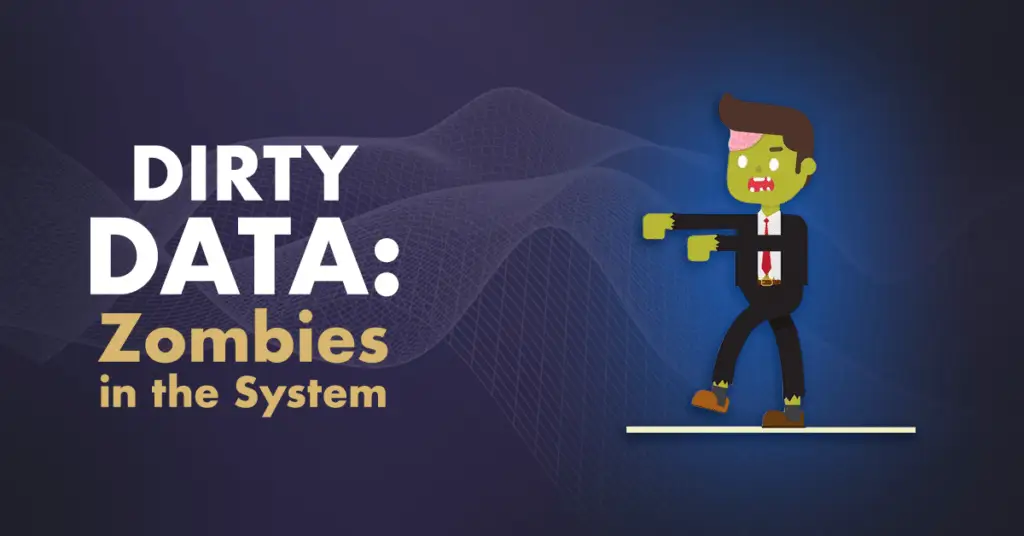
Halloween is coming up soon! As your company adjusts planned promotional campaigns to be seasonally appropriate, you may be overlooking a Halloween disaster waiting to happen. Check your customer contact database. How much of it can politely be called “dirty data”? If too many of your contacts are unusable for one reason or another, you have something of a zombie situation on your hands.
What is Dirty Data?
Simply put, “dirty data” is any marketing data that can’t be used because it’s outdated or incorrect. This is especially problematic in customer contact info, where customers may have input fake information to avoid being contacted. Obviously, these records are dead ends. Common sources of dirty data include:
- False information: As stated above, some customers deliberately give fake names and contact info to take advantage of an offer without being contacted.
- Expired data: These customers provided legitimate information, but for whatever reason, the provided data no longer works. Maybe they’ve since abandoned the provided email address or switched phone numbers.
- Typos: Even a simple typo can result in an unusable entry, or an embarrassing mistake.
- Duplicate data: This can result in accidentally messaging the same contact multiple times.
- Data in the wrong fields: A customer who accidentally puts a phone number in the email address field could confuse your email automation system.
- Format errors: This can be a mistake on the customer’s part, or the result of a computer hiccup as you transfer data. Either way, the data becomes unreadable.
Whatever the cause, these dirty data entries take up space in your records that could be occupied by actual leads.
The Dirty Data Snowball Effect
A few unusable entries may not seem like a big deal. But if left unchecked, dirty data can snowball. For example, consider the example of a misspelled record. Suppose a customer indicated that they’re the vice president of a company. They could have input this info in a variety of ways, including but not limited to:
- Vice President
- VP
- V.P.
- V. President
To a human, these entries clearly all mean “vice president”. But unfortunately, automated systems aren’t humans. A poorly maintained email automation system will view each of these entries as a completely different title and craft emails accordingly. This affects everything from email personalization to lead generation to confusing marketing reports. What started out as a simple typo snowballed into a significant problem.

Is Dirty Data Really That Bad? Yes
Clearly, typos can create dirty data entries that can give your marketing team a lot of grief. But what about fake names or no-longer-usable contact info? Those are mostly harmless, right?
Unfortunately, no. Dirty data touches nearly every step of the marketing process, including:
- Initial data storage: Many marketing softwares, including Eloqua, charge per contact. Useless contacts aren’t just taking up space in your database—they may be quite literally costing you money!
- Personalized messages: Imagine crafting a perfectly personalized email, only for the wrong person to receive it. Worse, what if the email is personalized to someone who provided an obviously fake name? Your message might open with “Dear Superman”. Customers won’t take these kinds of emails seriously.
- Data segmentation: Dirty data interferes with your marketing segments, making it harder to target the right audience.
- Metrics: Incorrect information can result in emails not being delivered, lower clickthrough rates, inaccurate sales numbers, and more.
- Lead nurturing: Your sales department uses the same data as the marketing department to reach out to potential leads. If both departments are using dirty data, they could be shooting themselves in the foot!
How to Perform a Data Checkup
You can and should regularly inspect your customer database for dirty data. However, the best way to remove dirty data from your system is to prevent it from getting in to begin with. At 4Thought Marketing, we’ve developed a simple process to clean up your data:
- Perform a data review: Look over the data you already have and identify any obvious problems.
- Remove the bad data: Delete unusable entries and, when possible, correct any that are obviously typos instead of deliberately fake data.
- Set up a data filtration system: The Contact Garbage Detector Cloud App for Eloqua can inspect data as it enters your system and remove any unusable entries.
- Assign a data manager: Have an employee dedicate their time to reviewing data in the system to catch anything the cloud apps missed.
Prevent the Zombie Apocalypse
There may not be a medical cure for dirty data like there (hopefully) is for a zombie outbreak. But there is a solution. A few extra minutes of work and data inspection can save your company a significant amount of time and money later on.
Get in touch with us today to start clearing the zombies out of your database!

